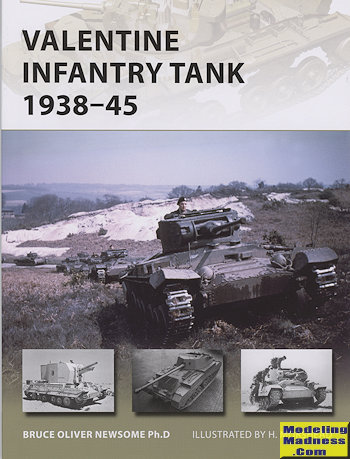 Considering
that the tank was basically a British invention, it is surprising that the
British Army found itself lagging behind in tank development until near the end
of World War II. Perhaps it was due to the perceptions of what was needed or an
inability to adapt to change. Whatever the reason, the majority of British tanks
were either under gunned, under armored, or both. Such is the case of the most
built British tank of WWII, the Valentine.
Considering
that the tank was basically a British invention, it is surprising that the
British Army found itself lagging behind in tank development until near the end
of World War II. Perhaps it was due to the perceptions of what was needed or an
inability to adapt to change. Whatever the reason, the majority of British tanks
were either under gunned, under armored, or both. Such is the case of the most
built British tank of WWII, the Valentine.
When this tank was developed in the late 1930s, British armor consisted
of three types; cruiser tanks that were relatively fast, but poorly protected,
infantry tanks that were well armored but had small main armament and tankettes,
which are useless for nearly all tasks aside from helping to keep the peace in
colonies.
Requiring medium tanks, the war office was looking for a development of
the Matilda II when Vickers proposed a tank with a 40mm main gun that would
allow the tank's overall dimensions to be smaller. This meant a claustrophobic
two man turret, but with a proven automotive portion that would require no
development. Initiated as a stop-gap, the Valentine was born.
The tank proved itself to be reliable, under armored and with a gun that
was too small to deal with German medium tanks. However, when you are at war,
you tend to develop what you have and build what is available, so it was with
the Valentine. It was developed into the Bison self propelled artillery vehicle,
the Archer anti-tank gun and a variety of bridge-layers, flame tanks and other
vehicles. Not surprisingly, the tank was replaced as soon as something better
became available, but continued to serve in secondary fronts and was widely
exported to the Soviets, who did not like it all that much.
The author provides a full account of the development of the tank as
well as a rundown on all the different variations on the theme that are the norm
with subjects like this. The photos are well chosen and the art work is superb.
The book also has a large section that provides quite a few specification
tables, and descriptions of things like the rangefinder, electrical power
system, how the controls operated, what it was like to drive it and things like
that. There is very little on its use in combat, which is something I have come
to expect from this series. Despite this, I found the book to be interesting to
read and a nice primer on this tank, which made up over a quarter of all British
armor production during WWII.
March 2016
Copyright ModelingMadness.com
For more on the complete line of Osprey books, visit
http://www.ospreypublishing.com
If you would like your product reviewed fairly and
fairly quickly, please
contact
the editor or see other details in the
Note to
Contributors.
 Considering
that the tank was basically a British invention, it is surprising that the
British Army found itself lagging behind in tank development until near the end
of World War II. Perhaps it was due to the perceptions of what was needed or an
inability to adapt to change. Whatever the reason, the majority of British tanks
were either under gunned, under armored, or both. Such is the case of the most
built British tank of WWII, the Valentine.
Considering
that the tank was basically a British invention, it is surprising that the
British Army found itself lagging behind in tank development until near the end
of World War II. Perhaps it was due to the perceptions of what was needed or an
inability to adapt to change. Whatever the reason, the majority of British tanks
were either under gunned, under armored, or both. Such is the case of the most
built British tank of WWII, the Valentine.